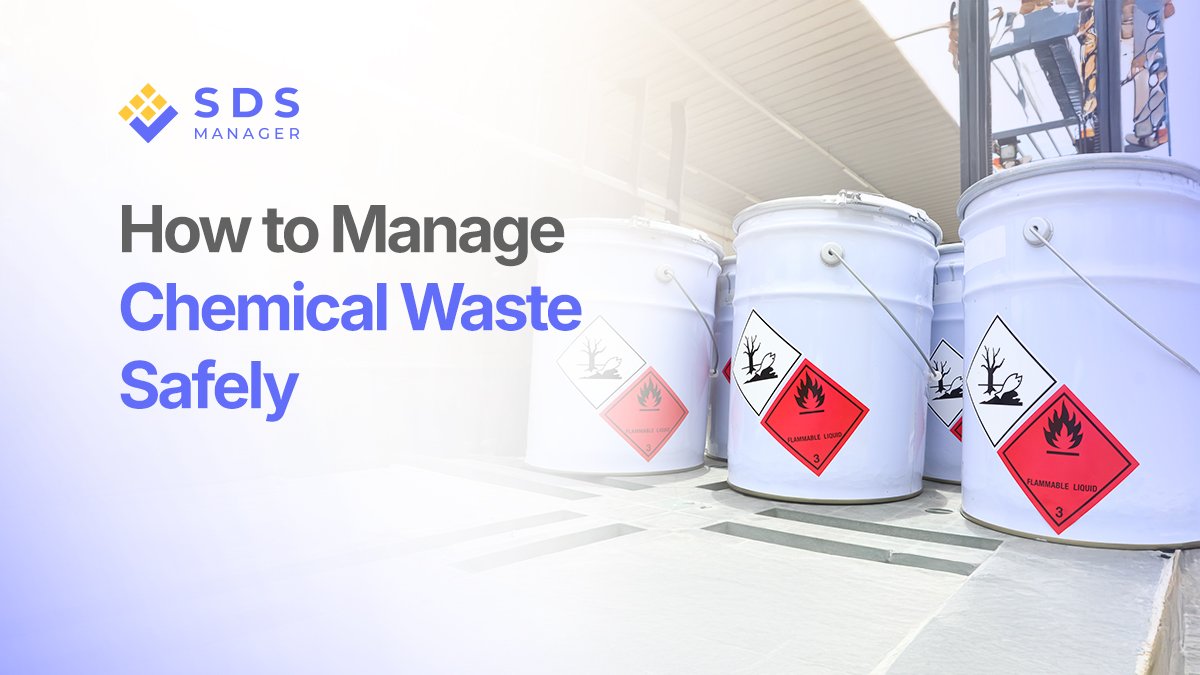

Chemical waste often hides in plain sight. Drums, bottles, and containers full of waste slowly pile up in corners of workshops, labs, and warehouses until it becomes a problem.
The truth is, managing chemical waste safely isn’t just about following regulations. It’s about protecting people, the environment, and the business itself.
Knowing how to manage chemical waste properly is one of the simplest and most effective ways to build a safer, cleaner workplace.
In this article, we’ll talk about the four simple steps you can follow to manage chemical waste safely.
Steps to Managing Chemical Waste Safely
Step 1: Identify and Classify Every Waste
The first rule in how to manage chemical waste is to know exactly what you’re dealing with. Start by labeling all containers as soon as any waste is collected. Each label must include the chemical name, hazard class, and date.
Mixing chemicals is never an option. Keep acids away from bases, and oxidizers separate from flammables. Even a small reaction between incompatible substances can release toxic fumes or cause a fire.
If you’re unsure about the category, refer to the Safety Data Sheet (SDS). The SDS gives you information about proper storage, handling, and emergency steps.
Many companies now use digital SDS management tools to make this step faster and safer. These tools give instant access to updated safety data sheets and help reduce mistakes during waste handling.
Step 2: Use the Right Containers
Next, make sure every waste type has its own proper container. Glass is good for corrosives, but not for hydrofluoric acid. Plastic works for many liquids but can soften or leak over time if used incorrectly.
The container must be in good condition, tightly sealed, and compatible with the material. Never use a bottle that once held a different chemical. Cross-contamination is dangerous and unpredictable.
The containers must also be clearly labeled with the words “Hazardous Waste” and kept closed unless you’re actively adding material. This small habit reduces vapor release and prevents spills.
Step 3: Store Waste Properly
Safe storage is the backbone of how to manage chemical waste. Store containers in a well-ventilated, cool area away from heat and sunlight.
Flammable waste stays in flame-proof cabinets. Corrosives stay in secondary containment trays. Reactive materials get their own space, far from anything that could start a reaction.
Also make sure the storage area has spill kits, absorbent materials, and emergency showers nearby. Accidents can happen even when you’re careful, and quick action makes all the difference.
Step 4: Dispose Waste Correctly
Once you’ve collected and stored waste properly, the next step is disposal. This step is highly regulated, and for good reason.
Never pour chemical waste down the drain, into the soil, or in the trash. Doing so can contaminate groundwater or public systems.
Instead, contact certified disposal services that specialize in how to dispose of industrial chemicals safely. They transport the waste to licensed facilities where it’s neutralized, treated, or incinerated under strict environmental rules.
Best Practices for Managing Chemical Waste
Train the People Who Handle It
Anyone who handles, stores, or transports chemicals should know how to manage chemical waste correctly.
I make sure training includes:
- How to read labels and SDS sheets
- How to use personal protective equipment (PPE)
- What to do during a spill or exposure
- Who to contact for help
Regular refreshers help prevent complacency. People forget rules when they don’t use them daily, so treat training as an ongoing process, not a one-time event.
Be Prepared for Emergencies
Even with all precautions, accidents can still happen. Keep spill control kits, eye wash stations, and fire extinguishers close to every chemical area.
Everyone should know where to find them and how to use them. Run mock drills every few months. It’s so that panic doesn’t take over when something real happens.
When a spill occurs, the first step is to protect yourself. Next, assess the situation, put on the right gear, and isolate the area. If the spill is too large or dangerous, call the emergency response team immediately.
Keep Records and Review Regularly
Recordkeeping may sound like a lot of work, but it’s essential for compliance. Every waste pickup, inspection, training session, and spill response should be logged and dated.
Regular reviews (ideally once a year) help catch problems early. Labels fade, containers wear out, and regulations evolve. A short check-in can prevent issues later.
Use Technology to Stay Organized
Digital tools have made chemical waste management easier than ever. There are softwares that track chemical usage and disposal. Many facilities use these software to track waste containers, pickup schedules, and disposal records.
Some systems even link directly to an SDS database or send alerts when it’s time for a collection. These features save time and reduce the risk of human error.
Work With Certified Partners
When it’s time to remove chemical waste, choosing the right disposal partner matters. Certified and licensed waste contractors know how to handle hazardous materials safely and legally.
A reliable contractor provides documentation that shows the waste was treated or disposed of correctly. This paperwork is critical during audits, inspections, or internal reviews.
Working with trusted professionals keeps waste management simple, compliant, and worry-free.
Final Thoughts
Proper chemical waste management isn’t complicated. It’s about structure, consistency, and care. Label things clearly. Store them safely. Train your team. Keep records.
These are simple steps, but they make a big difference. Many organizations have closed compliance gaps and improved safety just by following these basics.
When chemical waste is managed well, people work safer, inspections go smoother, and the environment stays protected.